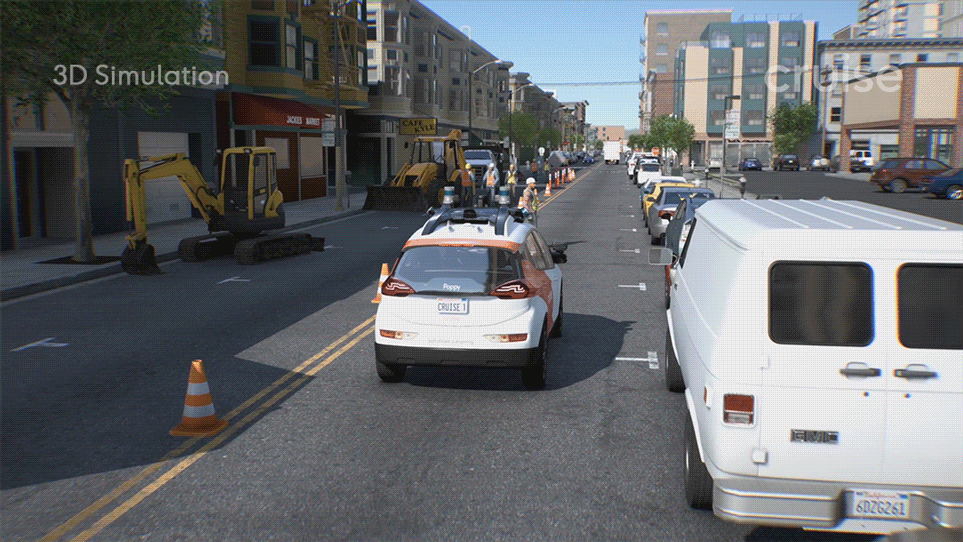On March 16th, we suspended our on-road testing following the initial guidance issued from Mayor London Breed and the public health officials. This required us to rethink our AV development loop. Our multi-year investments in simulation have resulted in very robust simulation capabilities, which allowed us to continue making rapid progress on AV performance while the majority of our vehicles are off the road.
Despite a heavy reliance on simulation, we still prefer to include road-testing to tease out gaps in our test coverage and discover things we may not be simulating correctly. Our development cycle typically follows a simple loop:
- Gather data by driving our fleet of autonomous vehicles (AVs) throughout San Francisco
- Analyze the data for new events, gaps, and opportunities to improve
- Update the AV code and simulation code
- Test the new AV code in simulation
- Deploy code to our AV fleet, and then go back to one
It is immediately obvious that to continue making progress, we must rely on our simulation software. Our simulation frameworks allow for AV code testing without real-world driving, but it’s not that simple. There are many challenges we must overcome and some caveats we must keep in mind. For starters, accuracy is a core challenge.

AV simulations must replicate what happens in the real world as accurately as possible in order to give correct feedback and signaling to engineering. We are on a continual quest to close the gap between our simulation results and what we see on the road with our physical test vehicles. We enforce accurate world rules and ensure our simulated vehicles accurately interpret the world and make good decisions.
https://medium.com/media/6470a34f6bfc4030f9a7d0ba033f25a8/href
For every scenario we want to test in simulation, we have to choose how much to invest in accuracy. No vehicle dynamics software model is perfectly accurate. They can get complex, and it would be easy for us to spend months of development effort to resolve extremely minor differences between how the AV acts in simulation and on the road.
https://medium.com/media/2308b42539a901e9b21f698d23031ebc/href
With limited time and resources, we have to make choices. We ask whether modeling tire sideslip is more important than other factors we have in our queue, like modeling LiDAR reflections off of car windshields and rearview mirrors or correctly modeling radar multipath returns.
Tire sideslip is a source of error, but the impact is minimal at lower speeds and it’s extremely complex to model, which makes it a less ideal candidate for engineering investment. When cars turn a corner, their rubber tires deform during the turn. The more the car drives, the wider the tires get, and the more they slip. The tire sideslip is dependent on the car’s mileage, road conditions and even the metal used on the axle. When deciding how accurately we should model the tire sideslip in our simulation, we think about different variables, including the effort that goes into modeling this factor and the impact of getting the modeling wrong.
Another way we manage trade-offs is our use of a variety of simulation frameworks to serve the different levels of accuracy different tests require. Some simulation frameworks don’t need 3D graphics to execute because they test subsystems of the AV stack. These simulations are easier to create, cheaper to execute, and can run on commodity hardware at 100x real-time. Meanwhile, other frameworks need full 3D visibility, weather simulation, and elevation data to be certain the simulated AV correctly interprets its surroundings. Based on what the simulation tests for, we know how to prioritize the different accuracy needs and compute resources.
Beyond the above challenges, we also have sensors to model. Decades of video game engines have taught us that we can create visual scene data for cameras (which is what you see when you play a video game), but what about LiDAR and radar? Many LiDARs capture 3D data in slices, and radar captures electromagnetic reflections which have the appearance of oddly-shaped blobs. The real challenge is how to accurately model LiDAR and radar in real time while balancing fidelity and runtime performance. It’s a complex problem involving refraction in the air, reflections, ghosting, and many complexities — much more than we can discuss today.
https://medium.com/media/38760373c2576c26082eec22cd2d2e30/href
Regardless of whether our vehicles are on the road, our AV engineers continue to test and develop code using our powerful Simulation frameworks. To continuously improve the vehicle’s performance, it’s crucial for simulation frameworks to have high-fidelity models, accurately simulated AV platforms, interactive and realistic roadway users (e.g. drivers, pedestrians, cyclists), and highly detailed environments. We believe that continued investment in simulation tools will lead to an even faster rate of improvement, so we will continue to invest in these frameworks for years to come.
If you’re interested in being at the epicenter of rapid AV development, consider joining us.
Rethinking Cruise’s AV Development Loop During COVID-19 was originally published in Cruise on Medium, where people are continuing the conversation by highlighting and responding to this story.
